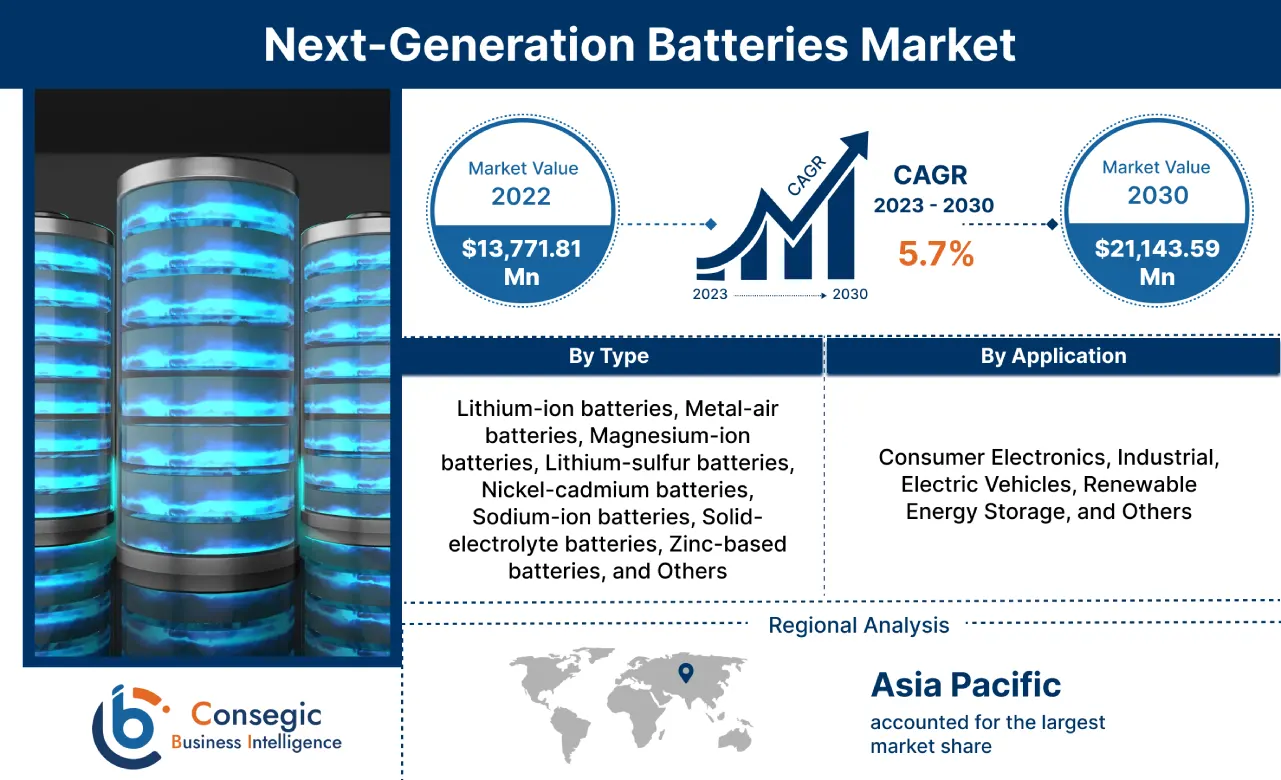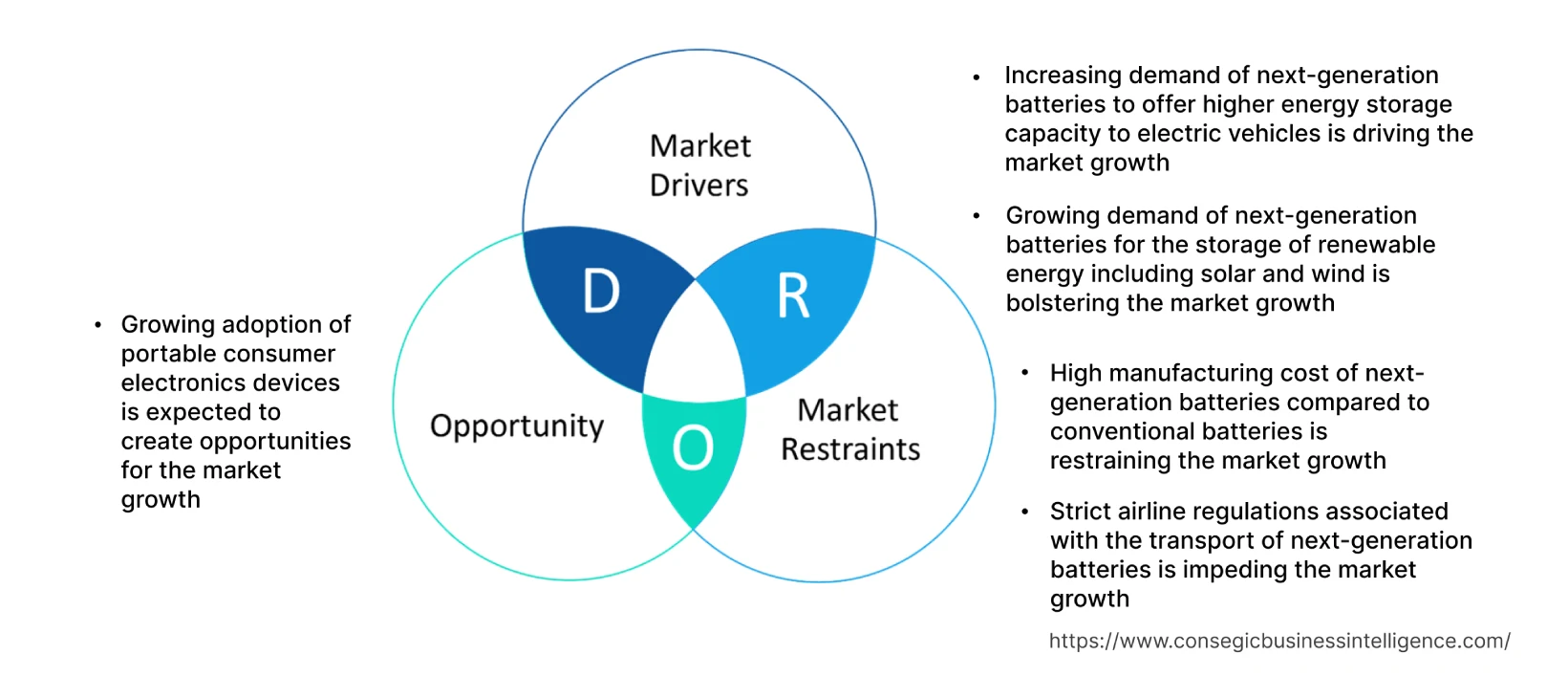- Summary
- Table Of Content
- Methodology
Next-Generation Batteries Market Introduction :
Next-Generation Batteries Market is estimated to reach over USD 21,143.59 Million by 2030 from a value of USD 13,771.81 Million in 2022, growing at a CAGR of 5.7% from 2023 to 2030.
Next-Generation Batteries Market Definition & Overview:
Next-generation batteries refer to advanced energy storage devices that aim to overcome the limitations of conventional battery technologies. The batteries incorporate innovative materials, designs, and manufacturing processes to enhance energy storage capacity, efficiency, safety, and lifespan. Additionally, these batteries are developed to address the increasing demand for more efficient and sustainable energy solutions in various applications, including electric vehicles, renewable energy integration, portable electronics, and grid-scale energy storage.
Next-Generation Batteries Market Insights :
Key Drivers :
Increasing demand for next-generation batteries to offer higher energy storage capacity to electric vehicles is driving the market.
Electric vehicles require batteries with high energy density to provide longer driving ranges. Next-generation batteries are being developed to offer higher energy storage capacity per unit of weight or volume, allowing EVs to travel farther on a single charge. The increased energy density is crucial for addressing driving range, thus contributing significantly to driving the adoption of batteries in electric vehicles. In addition, these batteries also aim to provide fast-charging capabilities, enabling EVs to charge quickly and conveniently. The development of advanced technologies including improved electrode materials, advanced electrolytes, and battery management systems reduces the charging times, hence contributing to accelerating the market. Moreover, the growing adoption of these batteries to achieve zero-emission goals and reduce global warming effects is further propelling the market.
- For instance, in June 2023, Panasonic Energy Co., Ltd. and Mazda Motor Corporation partnered together to launch a next-generation lithium-ion battery to provide high energy storage capacity to electric vehicles. The high-storage batteries are developed to achieve zero emissions goals and also to curb the global warming effects, hence contributing notably to fueling the market.
Growing demand for next-generation batteries for the storage of renewable energy including solar and wind is bolstering the market.
Renewable energy sources are intermittent in nature and fluctuate based on weather conditions. These batteries provide energy storage solutions to store excess electricity generated during peak production periods and release the energy when demand is high and renewable generation is low. The batteries help to balance the grid, ensure a stable power supply, and enable higher penetration of renewables in the energy mix by smoothing out the fluctuations.
Additionally, these batteries allow for demand shifting, by storing excess renewable energy during low-demand periods and discharging during high-demand periods. The capability helps to optimize the use of renewable energy resources, reduces the need for traditional fossil fuel-based power plants, and contributes to grid stability. Furthermore, these batteries enable consumers and businesses to maximize the utilization of clean energy and reduce reliance on non-renewable sources during peak hours. In conclusion, the expanding renewable energy sector is raising the adoption of these batteries for energy storage and grid stability.
- For instance, in May 2023, TotalEnergies SE launched the largest renewable energy storage project at Antwerp refinery in Belgium. The project aims to ensure the stability of the European and Belgian grids and also to offer advanced storage solutions. Thus contributing notably to boosting the next-generation batteries market demand.
Key Restraints :
The high manufacturing cost of next-generation batteries compared to conventional batteries is restraining the market.
Next-generation batteries incorporate advanced electrolytes namely solid-state electrolytes and polymer electrolytes, to offer higher conductivity, improved safety, and wider operating temperature ranges. The advanced electrolytes are more expensive than traditional liquid electrolytes including lithium salt in an organic solvent. Additionally, these batteries require specialized electrode materials that offer improved energy density, power density, and cycling performance. For instance, lithium-ion batteries with high-capacity cathode materials namely nickel-cobalt-aluminum (NCA) and nickel-manganese-cobalt (NMC) are more expensive than conventional lithium-ion batteries with lower-capacity cathode materials including lithium-iron-phosphate (LFP). Consequently, analysis of market trends depicts that the incorporation of advanced electrolytes and electrode materials accounts for additional upfront costs, thus hampering the next-generation batteries market demand.
Strict airline regulations associated with the transport of next-generation batteries are impeding the market.
Stringent airline regulations restrict passengers from carrying next-generation batteries on flights, limiting the adoption of batteries for personal use. The imposition of strict regulations prevents travelers from carrying battery-powered devices or spare batteries in their carry-on baggage, thus discouraging consumers from purchasing and using products that rely on these batteries. Additionally, the restrictions are imposed owing to the highly inflammable nature of the batteries which increases the probability of fire breaks. For instance, Delta Air Lines, Inc. permits travelers to carry a lithium-ion battery of a maximum of 160 watt hours per battery. The airline prevents more than 160 watt hours of batteries from being transported, thus hampering the next-generation batteries market growth.
Future Opportunities :
Growing adoption of portable consumer electronics devices is expected to create market opportunities.
Consumers' demand for longer battery life in portable devices including smartphones, tablets, laptops, and wearables is projected to create market opportunities. Next-generation batteries with higher energy density and improved performance offer extended usage time between charges, thus enhancing the user experience and convenience. Additionally, these batteries also enable faster charging which significantly improves the user experience by reducing downtime. Advanced battery technologies, incorporating fast-charging capabilities and solid-state batteries with improved charging efficiency, have the potential to meet the growing requirement for rapid charging in portable consumer electronics devices. In conclusion, the market trends analysis shows that the growing need for advanced batteries to enhance the battery life of portable consumer electronics devices is anticipated to create next-generation batteries market opportunities.
Next-Generation Batteries Market Report Insights :
| Report Attributes | Report Details |
| Study Timeline | 2017-2030 |
| Market Size in 2030 | USD 21,143.59 Million |
| CAGR (2023-2030) | 5.7% |
| By Type | Lithium-ion batteries, Metal-air batteries, Magnesium-ion batteries, Lithium-sulfur batteries, Nickel-cadmium batteries, Sodium-ion batteries, Solid-electrolyte batteries, Zinc-based batteries, and Others |
| By Application | Consumer Electronics, Industrial, Electric Vehicles, Renewable Energy Storage, and Others |
| By Region | North America, Europe, Asia-Pacific, Latin America, and Middle East & Africa |
| Key Players | Ambri Inc., Contemporary Amperex Technology Co Ltd, GS Yuasa Corporation, Ilika PLC, Johnson Matthey PLC, LG Chem Ltd., Mitsubishi Chemical Corporation, Panasonic Energy Co., Ltd., PolyPlus Battery Co Inc., ProLogium Technology, Sion Power Corporation, TotalEnergies SE |
Next-Generation Batteries Market Segmental Analysis :
Based on the Type :
The type segment is classified into lithium-ion batteries, metal-air batteries, magnesium-ion batteries, lithium-sulfur batteries, nickel-cadmium batteries, sodium-ion batteries, solid-electrolyte batteries, zinc-based batteries, and others.
Lithium-ion batteries accounted for the largest market share of the total next-generation batteries market share in 2022 and are also projected to witness the fastest CAGR during the forecast period. The growth of the market is endorsed by the increasing adoption of lithium-ion batteries owing to the high energy density to store significant amounts of energy in a relatively small and lightweight package. Additionally, lithium-ion batteries have a long cycle life and are easily charged and discharged without significant capacity degradation. The longevity makes the batteries suitable for applications that require frequent use and recharge, including consumer electronics and electric vehicles. Moreover, segmental trends portray that lithium-ion batteries are extensively adopted across various industries and applications, including consumer electronics, electric vehicles, energy storage systems, and renewable energy integration.
Furthermore, the increasing investment by key players in the development of lithium-ion cell manufacturing plants for sustainable electric mobility is also contributing to the next-generation batteries market trends.
- For instance, in April 2022, Log9 Materials developed a lithium-ion cell manufacturing facility in Bengaluru with an initial investment of USD 25 million and a capacity of 25 megawatt-hours (MWh). The aim of the company is to attain 5 gigawatt-hours by 2026 to meet sustainable electric mobility.
Thus, the analysis of segmental trends shows that contributing remarkably to fueling the next-generation batteries market growth in the upcoming years.
Based on the Application :
The application segment is classified into consumer electronics, industrial, electric vehicles, renewable energy storage, and others.
Consumer electronics accounted for the largest market share of 36.4% of the overall next-generation batteries market share in 2022 as batteries are poised to revolutionize consumer electronics, offering improved performance, longer battery life, and enhanced user experiences. In addition, these batteries enable smartphones and tablets to have longer battery life, faster charging capabilities, and improved energy efficiency, hence driving the growth of the consumer electronics segment. Moreover, these batteries significantly enhance the battery life of laptops and ultrabooks, allowing users to work, browse, and stream content for longer periods eliminating the need to charge the device repeatedly. Furthermore, the compact and lightweight nature of these batteries is ideal for wearable devices namely smartwatches, fitness trackers, and augmented reality (AR) glasses. The batteries provide extended longevity and enable efficient functioning of advanced features including continuous heart rate monitoring, GPS tracking, and immersive AR experiences. Subsequently, the analysis of segmental trends depicts that the aforementioned factors are collectively responsible for accelerating the next-generation batteries market expansion.
The electric vehicle segment is anticipated to register the fastest CAGR during the forecast period. The growth is credited to the ability of batteries to offer higher energy storage capacity per unit of weight, allowing EVs to travel farther on a single charge. Additionally, the emergence of all-solid-state batteries allows improved tolerance of high temperature and voltage, resulting in increased power output, shorter charging times, and a longer range of electric vehicles. For instance, in June 2023, Toyota Motor Corporation unveiled Toyota's next-generation battery technology to provide high-energy storage capacity to electric vehicles. Toyota's battery-electric vehicles are expected to be introduced in the market in 2026 and 1.7 million of the 3.5 million Toyota's battery-electric vehicles are expected to sell in 2030. In conclusion, as per the next-generation batteries market analysis, the surge in the sales of electric vehicles is increasing the requirement for batteries, which in turn, promotes next-generation batteries market trends.
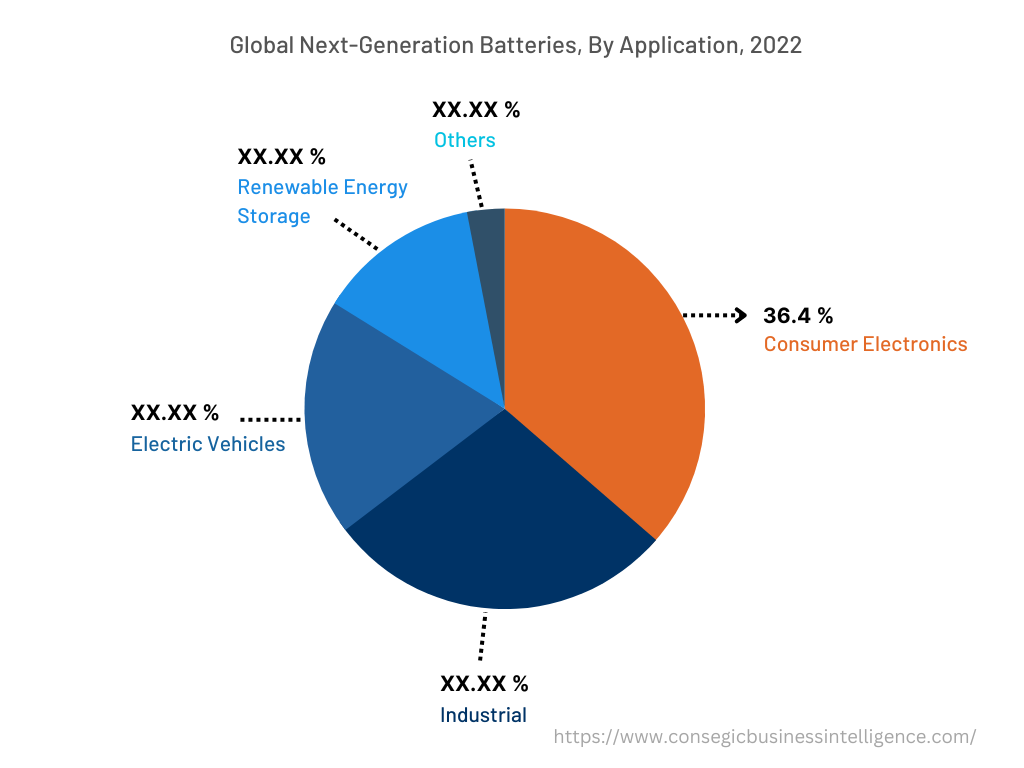
Based on the Region :
The regional segment includes North America, Europe, Asia Pacific, the Middle East and Africa, and Latin America.
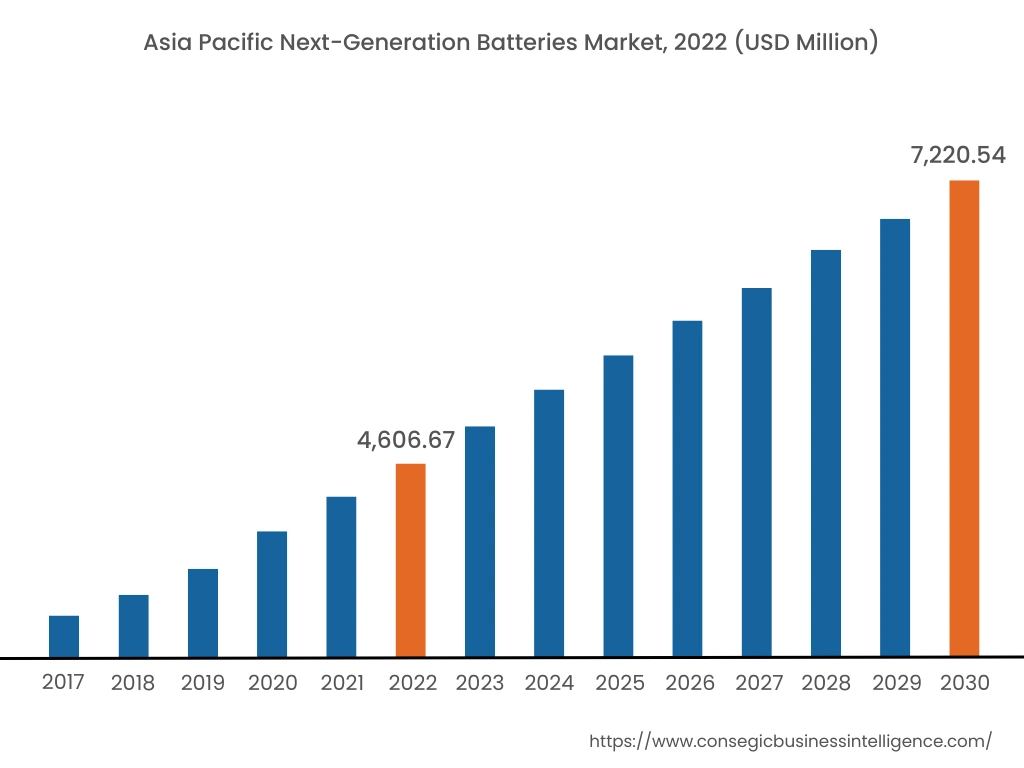
Asia Pacific accounted for the largest market share in 2022 accounting for USD 4,606.67 Million and is expected to register the fastest CAGR of 6.0% accounting for USD 7,220.54 Million in 2030 in the next-generation batteries market. In addition, in the region, China accounted for the maximum revenue share of 37.10% in the year 2022. The growth is attributed to the expanding consumer electronics market, including smartphones, tablets, laptops, and other portable devices that raise the requirement for batteries to enable faster charging by reducing downtime. Additionally, Asia Pacific has a strong manufacturing base and a well-established supply chain for battery technologies. The next-generation batteries market analysis shows that countries including China, Japan, and South Korea are at the forefront of battery production, investing heavily in research and development, manufacturing facilities, and advanced battery technologies.
Moreover, Asia Pacific also encompasses the world's leading battery technology companies and research institutions. The entities are investing heavily in developing advancements in battery technologies, including lithium-ion batteries and emerging technologies namely solid-state batteries and lithium-sulfur batteries. The expertise and technological advancements offer Asia Pacific a competitive edge in the global market, thus contributing remarkably to propelling the market growth. For instance, in September 2021, TDK Ventures invested in AM Batteries to commercialize dry electrode coating technology to improve the manufacturing of lithium-ion batteries. Thus, the regional trends analysis shows that advanced technology enables fast charging, higher energy density, and cost-effective measures, hence contributing considerably to accelerating the next-generation batteries market expansion.
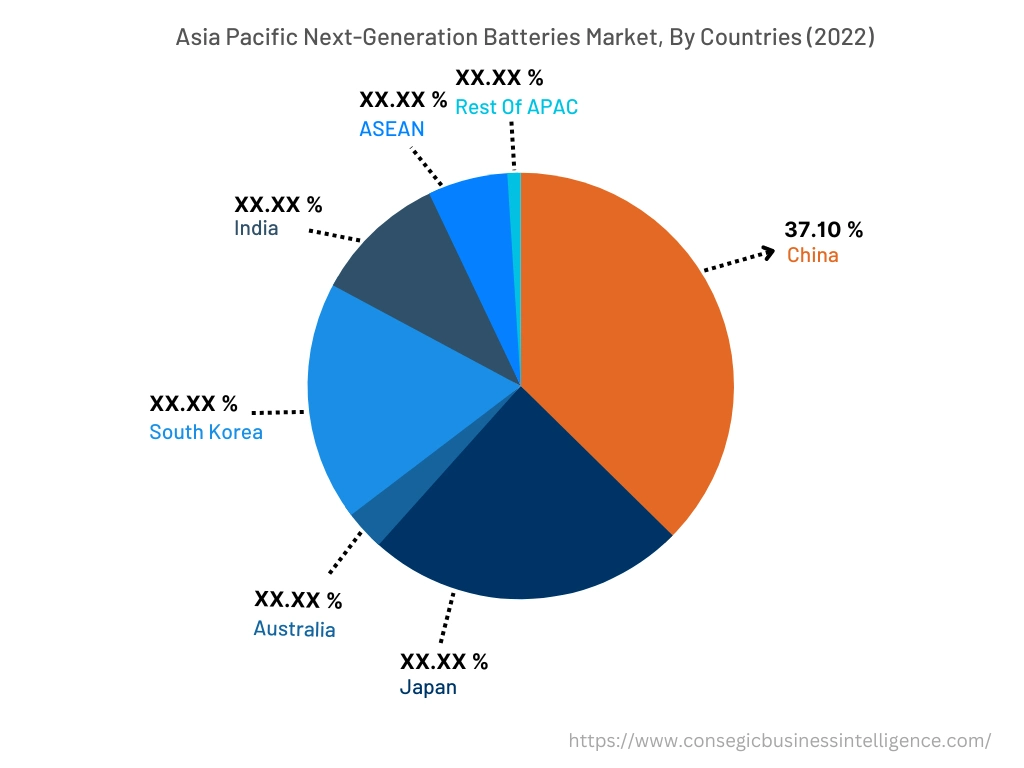
Top Key Players & Market Share Insights:
The landscape of the global next-generation batteries market is highly competitive. The key players in the market are adopting strategies for acquisitions mergers, and product innovations to stay competitive in the market. Following are the major market players that comprise the latest next-generation batteries market concentration: –
- Edmund Optics
- Excelitas Technologies Corp
- OSRAM Optoelectronics
- Rohm Semiconductor
- Semtech Corporation
- First-sensor AG
- Hamamatsu Photonics Deutschland
- Panasonic Corporation
- Kyosemi Corporation
- OSI optoelectronics
Recent Industry Developments :
- In March 2021, IMB-CNM celebrated the fifth launch of 36 of the OneWeb satellites, equipped with photodiodes and constructed in the Clean Room of the Barcelona Institute of Microelectronics. The satellites are composed of solar tracking sensors that comprise silicon photodiodes to serve as solar tracking sensors for the satellites.
- In February 2020, Panasonic Corporation introduced a time-of-flight image sensor with an advanced avalanche photodiode of one million pixels to offer high resolution and sensitivity to the TOF image sensor.
Key Questions Answered in the Report
What are next-generation batteries? +
Next-generation batteries refer to advanced energy storage devices that aim to overcome the limitations of conventional battery technologies. The batteries incorporate innovative materials, designs, and manufacturing processes to enhance energy storage capacity, efficiency, safety, and lifespan.
What specific segmentation details are covered in the next-generation batteries market report, and how is the dominating segment impacting the market growth? +
Consumer electronics accounted for the largest market share in 2022 as next-generation batteries are poised to revolutionize consumer electronics, offering improved performance, longer battery life, and enhanced user experiences.
What specific segmentation details are covered in the next-generation batteries market report, and how is the fastest segment anticipated to impact the market growth? +
Electric vehicles are anticipated to have the largest impact on next-generation batteries market during the forecast period. The growth is credited to the ability of batteries to offer higher energy storage capacity per unit of weight, allowing EVs to travel farther on a single charge.
Which region is anticipated to witness the highest CAGR during the forecast period, 2023-2030? +
Asia Pacific is expected to witness the fastest CAGR in the upcoming years as the region is witnessing a significant rise in the consumer electronics market and also due to the presence of key players in the region.
